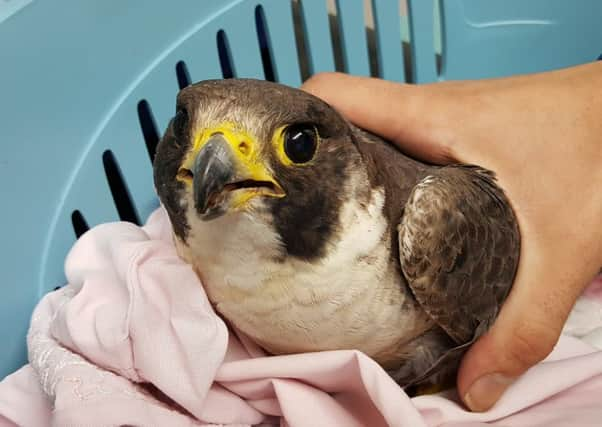TREVOR WEEKS: Young peregrine falcon arrives during another busy period


Along with a couple of kestrels and sparrowhawks we have admitted this week, we have had another peregrine falcon come into care.
This time, a youngster found by Eastbourne Railway Station. It is unclear why it was on the ground and unable to fly but it is possible the bird may have flown into something. The bird is booked in for our vets to assess.
Advertisement
Hide AdAdvertisement
Hide AdWe have had a number of cases recently where people have kept casualties for days thinking they can just clean a wound and just provide food and water for a casualty to recover.
We have a very poorly pigeon in care at the moment who can hardly keep its head up. The finder kept the bird for four days before passing it onto us. All too often we hear people say “we thought it was going to die so left it alone”, or they mistakenly believe nobody will be interested if it close to death and likely to die soon.
WRAS will respond quicker to the more urgent cases or advise a local vets or other organisation is that is the best and quickest option for the sake of the casualty. Often by the time some casualty is passed to us it is too late and then impossible to save. The sooner we get a casualty admitted the more change we have of saving its life. We had a poorly hedgehog come in from St Leonards via Bexhill Wildlife Rescue after it had what appeared to be a nasty strimmer injury. WRAS’s care team provided emergency first aid, removed fly strike and maggots plus cleaned up the wound, but sadly the wound had been necrotic and too badly damaged to even amputate the leg.
If you are clearing vegetation please check the area before strimming to avoid these casualties.
Advertisement
Hide AdAdvertisement
Hide AdOur night time rescues have continued. Chris is currently on-call at night time and like my last two weeks on call, he has been extremely busy. Monday night rescuers responded to a gull at Tesco in Lottbridge Drove with a fractured wing, a gull at Sussex Police’s custody centre, a starling in a chimney in Percival Road, Hampden Park, an injured pigeon in Ceylon Place, an injured fledgling in Hampden Park and a badly injured wood pigeon in Marsden Road, Eastbourne.
Calls continued into the night with two fox rescues, one in Isfield and one just outside our hospital at Whitesmith. Sadly neither of them survived their injuries. On a happier note we have had a lovely little sparrow admitted from Waldron, one of our volunteers dropped off a stunning little finch and a gull that was trapped between two 7ft foot fence panels was freed. We have had an underweight kittiwake admitted into care from Seaford. The bird is having to be carefully fed and built up slowly. The bird is a youngster in its adolescent colours.
Two swans have been rescued over the past week. One swan decided to walk out of Princes Park Eastbourne and tried to pay the Co-Op a visit on Seaside near Wartling Road. A member of the public helped keep the bird safe till rescuer Chris arrived and returned the swan to the lake.
A cygnet from Leeds Avenue had to be rushed up to the Swan Sanctuary after being found very lethargic and underweight at Leeds Avenue, observant local residents noticed the cygnet and phoned it through.
Advertisement
Hide AdAdvertisement
Hide AdTuesday’s rescuers rushed to Hurst Green after Sussex Police called about an injured duck. A group of juvenile ducks was reported several times trying to cross the busy A21. They were cleared from the road but returned later. The second occasion the ducks were encourage to the opposite side of the road where they entered a field and started walking away from the road.
However, the police discovered a duck by the hedgerow unable to walk. I rushed across and met the police where I was able to provide emergency medication and transport her back to WRAS’s casualty centre for assessment. Due to a fracture in the leg and wing, specialist veterinary assessment will be needed up at the Swan Sanctuary.
WRAS was established as a voluntary group in 1996 but some of its rescuers have been rescuing since 1985. The organisation was set up in order to provide a front-line rescue service for wildlife casualties who, unlike their domesticated cousins, do not have owners to help look after them. Our service is free of charge but the average cost to the charity of responding to and dealing with a call-out is £85, which includes veterinary bills, food, water, electric, bedding, caging, rescue equipment, vehicles and fuel, phone bills and other necessary expenses.